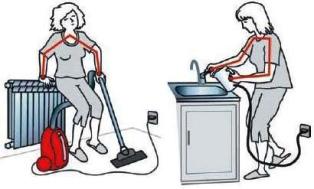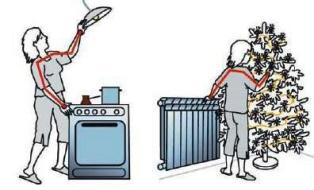Categories: Novice electricians, Electrician at home, Repair of household appliances, Safety precautions
Number of views: 57368
Comments on the article: 5
Electricity and electrical safety: educational program for beginners electricians
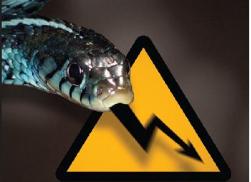 Electricity has so long and firmly entered our everyday life, that it seems as if it was open during the invention of the wheel, and maybe even earlier. The popularity of the use of electrical energy is very simple to explain: it is electricity that drives various mechanisms and machines, electric vehicles and all kinds of household appliances.
Electricity has so long and firmly entered our everyday life, that it seems as if it was open during the invention of the wheel, and maybe even earlier. The popularity of the use of electrical energy is very simple to explain: it is electricity that drives various mechanisms and machines, electric vehicles and all kinds of household appliances.
It helps to facilitate various work and organize leisure: remember how much time we spend in front of a TV, computer or home theater. At the same time, electricity is not noticeable, does not make noise, it has no color and smell.
You can detect it only with the help of instruments, in the simplest case, such an instrument is an ordinary light bulb or indicator screwdriver. But often this “invisibility” can turn electricity from a good helper into an evil enemy, from creative energy to destructive, and sometimes even deadly. Moreover, unsuccessful experiments with electricity can cause fear for such work for life.
Home experiences with electricity
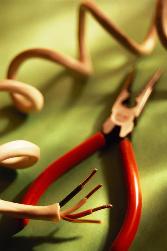 Each of us, of course, had to turn on the light bulb, repair the burned cord on the iron, and tighten the contacts in the outlet. Moreover, it is not necessary to have a special electrical engineering education. About the same as it is not necessary to know to the smallest detail the device of an internal combustion engine in order to become a car enthusiast. Minor malfunctions can be eliminated and, not knowing the whole car as a whole, and in serious cases you can always contact a car service.
Each of us, of course, had to turn on the light bulb, repair the burned cord on the iron, and tighten the contacts in the outlet. Moreover, it is not necessary to have a special electrical engineering education. About the same as it is not necessary to know to the smallest detail the device of an internal combustion engine in order to become a car enthusiast. Minor malfunctions can be eliminated and, not knowing the whole car as a whole, and in serious cases you can always contact a car service.
It is exactly the same with electricity: it is completely optional to invite an electrician from the ZhKO to replace an unusable switch or socket. But at the same time, one must know the danger of electricity, and what rules must be observed so as not to lose forever the desire for such work. Indeed, you must admit that it’s not at all fun to sit all day and wait until the good uncle arrives and clicks “cut down” automatic or RCD, because you are afraid to do it yourself or just don’t know about it.
Of course, for serious electrical installation, a whole tool kit, but first you should get acquainted with the rules of electrical safety and at least with the basics of electricity.
The danger of electricity
So why is electricity dangerous to the human body? Here are two main reasons. This is a simple mechanical damage to tissues, and in addition, the impact on the human nervous system, leading to very serious consequences.
From the history of the development of electricity, it is known that the Italian doctor Luigi Galvani used prepared frogs in his experiments, because there were no electrical measuring instruments at that time. A weak electric current passed through the nerve endings made the frog legs muscles contract.
Now this phenomenon has been studied quite well, and everyone knows that not only the frog legs, but also all the muscles of a person, including the heart, are reduced by electricity pulses generated by the central nervous system. A person has his own electricity, very low-power, but sufficient to control the whole organism, all its organs.
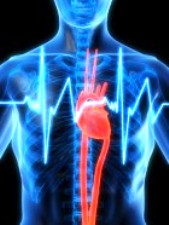 In the case of human contact with a bare conductor under current, two dangerous situations are possible. The first is the effect on the nervous system. As mentioned above, the human body is controlled by weak electrical impulses.If an electric current passes through human tissue from an external source, the body reacts to it, as if to the electrical signals of its central nervous system. But external signals can turn out to be much stronger than internal ones, they can simply be "drowned out", therefore they cause a random, convulsive contraction of the muscles, which come into a state of constant tension and cannot be relaxed. In such cases, they say that electric current attracts.
In the case of human contact with a bare conductor under current, two dangerous situations are possible. The first is the effect on the nervous system. As mentioned above, the human body is controlled by weak electrical impulses.If an electric current passes through human tissue from an external source, the body reacts to it, as if to the electrical signals of its central nervous system. But external signals can turn out to be much stronger than internal ones, they can simply be "drowned out", therefore they cause a random, convulsive contraction of the muscles, which come into a state of constant tension and cannot be relaxed. In such cases, they say that electric current attracts.
From here follows the golden rule, known to all electricians: You can touch bare wires only with the back of your hand, although you shouldn’t do this for no particular reason.. With this touch, the palm simply clenches into a fist, and the hand is repelled from the exposed wire. Otherwise, the hand will grip the conductor so tightly that there will be no way to unclench it, and the person will be under long-term exposure to electric current, which, of course, is very dangerous.
The strength of the current through the body can be so great that the powerful muscle contractions caused by it, current, often lead to rupture of ligaments, dislocations, and even fractures. Therefore, in films and safety posters, a person who has been exposed to electric shock is portrayed as shaking and with his hair standing on end. Secondly, these are mechanical damage to body tissues, which can be divided into physical and chemical ones by their effects.
Properties of various current sources
The main striking factor of electricity is not high voltage, as most citizens think, but the current flowing through the human body. Everyone saw the bluish sparks of static electricity that occur when taking off clothes. The voltage of such sparks is in the range of 7 - 10 thousand volts. But the power of such a current source is extremely small, so such electricity can not bring any harm to the body.
Touching ordinary wires of the lighting network is much more dangerous and unpleasant: at a voltage of only 220 V, the output current of such wiring can reach 16 - 20 A. Such a source is quite capable of giving out a dangerous and even fatal current for humans.
According to safety regulations, a person begins to feel an alternating current from 1 milliampere passing through the body. A current of 10 mA is considered dangerous, with such a current a person is still quite able to break away from the live part on his own. A current of 50 milliamps or more is considered fatal and can be fatal.. The question of these current values is often asked at periodic certifications of electricians. Alternating current has a negative effect on a person at somewhat lower values than constant, but there are much fewer contacts with direct current, at least in everyday life.
The most typical cases of electric shock in everyday life are shown in the figures. The arrows in the pictures indicate the path of the current passing through the body. Currents pass through the chest and heart region.
It is these contacts that can cause cardiac arrest, lead to respiratory arrest, which does not bode well. All of them are caused by human contact with faulty electrical appliances, radiators, gas equipment or even just water pouring from a faucet. In such cases, the installation of protective devices will not be out of place RCD. This will be discussed in future articles. In the meantime, remember what harmful effects on humans can have an electric current.
Physical effects of electric current
 As is known from the laws of physics, the electric current passing through the conductor causes it to heat up. It is enough to recall an electric stove or just an incandescent lamp. In our case, such a conductor is a person who has come under the influence of current. Heat will also be generated inside the tissues. How much and how much, it all depends primarily on the condition of the skin, in other words, the skin.
As is known from the laws of physics, the electric current passing through the conductor causes it to heat up. It is enough to recall an electric stove or just an incandescent lamp. In our case, such a conductor is a person who has come under the influence of current. Heat will also be generated inside the tissues. How much and how much, it all depends primarily on the condition of the skin, in other words, the skin.
The electrical resistance of the skin in all people is individual and depends on many reasons. It is this resistance that limits the current through the body. There are cases when a person for a long time held two wires from an outlet with his hands without any harmful consequences. But this is more likely a happy exception than a rule: after all, most people cannot do this trick, and touching a bare wire is, for most, if not fatal, then very sensitive.
Under certain conditions, skin resistance is significantly reduced. This can be caused by a person’s disease state or simply when the skin is wet, dampened with water or sweat. Under such conditions, the current flowing through the body is much higher, more heat is generated in the body, and the consequences may be more severe. There are cases when an electric current directly fry internal organs, while not leaving visible marks and damage on the skin surface.
See this topic: What determines and how the resistance of the human body changes
A current of the order of 30–50 mA passing through the region of the heart can lead to fibrillation (flutter) of the heart and to its subsequent reflex stop. If the current does not affect the heart muscle, then paralysis of the respiratory muscles is quite possible, which also does not bode well. After all, the paths of electric current in the body are unpredictable and bizarre.
In addition, simply superficial burns of the skin are possible, as well as damage to the retina of the eye during outbreaks of the electric arc at the time of short circuit. A retina burn with harsh ultraviolet light can lead to inversion of color perception, or even blindness, temporary or even permanent.
Chemical effects of electric current
An electric discharge passing through human tissues causes changes in the electrolytic properties of lymph, blood, tissue fluid, etc. Such changes are very harmful, because the composition of the blood must be unchanged and remain so all the time. A serious illness of the body can cause a change in the properties and number of red blood cells, a change in acidity and chemical composition.
From all that has been said above, conclusions can be drawn, and they are unfavorable: any unforeseen contact with electricity, although not always fatal, but quite unpleasant. The severity of the lesion depends primarily on the strength of the current and the duration of its effect on the body.
Very serious consequences do not always arise: according to statistics, only one case in 120 - 140 thousand unexpected contacts with electricity ends in death. Although, quite often, there are injuries of varying severity, which does not give reason to relate to these cases without proper attention. This is especially true in situations where a person works with electricity every day - in the repair of electrical equipment or installation work.
Studying the rules of electrical safety, the use of protective equipment, will help, if not completely avoid it, then at least minimize the risk of electric shock. These rules and tools will be discussed in the next article.
Boris Aladyshkin
See also at i.electricianexp.com
:

